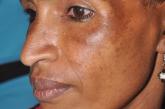Article
The Use of Tranexamic Acid and Microneedling in the Treatment of Melasma: A Systematic Review
- Author:
- Idowu D. Olugbade, BS
- Nicole A. Negbenebor, MD
Combination therapy with tranexamic acid (TXA) and microneedling is a safe and effective treatment for melasma.
Article
Suture Selection to Minimize Postoperative Postinflammatory Hyperpigmentation in Patients With Skin of Color During Mohs Micrographic Surgery
- Author:
- Carolina Gonzalez Bravo, BS
- Nicole A. Negbenebor, MD
Although absorbable gut sutures are popular, they are highly reactive and can induce inflammation in patients with skin of color. Choosing less...
Article

Melasma
- Author:
- Nicole A. Negbenebor, MD
- Candrice R. Heath, MD
- Richard P. Usatine, MD
Melasma (also known as chloasma) is a pigmentary disorder that causes chronic symmetric hyperpigmentation on the face. In patients with...
Article

Melasma
- Author:
- Nicole A. Negbenebor, MD
- Richard P. Usatine, MD
- Candrice R. Heath, MD
Hyperpigmentation on the cheeks, bridge of the nose, and upper lip in a Hispanic woman. What's the diagnosis?
Article

The Power of a Multidisciplinary Tumor Board: Managing Unresectable and/or High-Risk Skin Cancers
- Author:
- Nicole A. Negbenebor, MD
Participating in a multidisciplinary tumor board allows residents to learn more about how to manage and treat high-risk skin cancers. The...
Article

Advice for Applying to Dermatology as an Applicant of Color: Keep Going
- Author:
- Nicole A. Negbenebor, MD
Dermatology is one of the most competitive medical specialties to apply for residency. There is a lack of diversity in dermatology, and the cause...
